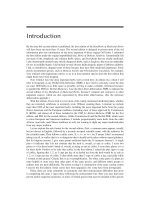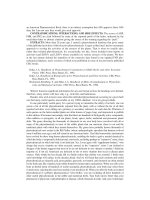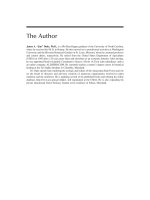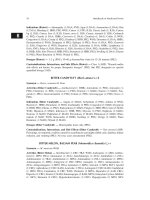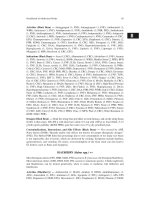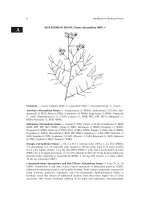Handbook of medicinal herbs phần 21
Bạn đang xem bản rút gọn của tài liệu. Xem và tải ngay bản đầy đủ của tài liệu tại đây (100.7 KB, 5 trang )
78
B
Handbook of Medicinal Herbs
Indications (Bistort) — Adenopathy (1; DAA; FNF); Ague (f; DAA); Amenorrhea (f; DAA); Bite
(f; DAA); Bleeding (f; HHB; PH2; WOI); Cancer (1; FNF; JLH); Cancer, back (f; JLH); Cancer,
lip (f; JLH); Cancer, liver (f; JLH); Cancer, nose (f; JLH); Cancer, stomach (f; JLH); Carbuncle
(f; PH2); Catarrh (f; DAA; HHB); Cervisosis (f; DAA); Circulosis (f; DAA); Colitis (f; WOI);
Congestion (f; DAA); Cramp (f; PH2); Diarrhea (f; HHB; PH2; WOI); Dysentery (f; DAA; HHB);
Dysmenorrhea (f; WOI); Dyspepsia (f; PH2); Epilepsy (f; PH2); Fever (f; DAA; PH2); Gastrosis
(f; JLH); Gingivosis (f; WOI); Hepatosis (f; JLH); Leukorrhea (f; DAA; HHB); Lymphoma (1;
DAA; FNF); Polyp (f; JLH); Rhinosis (f; JLH); Scrofula (f; DAA; PH2); Snakebite (f; PH2); Sore
(f; HHB; JLH); Sore Throat (f; HHB; PH2); Stomatosis (f; HHB; PH2); Swelling (f; DAA); Tetanus
(f; PH2); Water Retention (f; WOI); Wound (f; PH2).
Dosages (Bistort) — 1–2 g (PNC); 50–60 g rhizome/liter water for 15–20 minutes (PH2).
Contraindications, Interactions, and Side Effects (Bistort) — Class 1 (AHP). “Hazards and/or
side effects not known for proper therapeutic dosages” (PH2) (but PH2 designates no specific
quantified dosage! JAD).
BITTER CANDYTUFT (Iberis amara L.) X
Synonym — Iberis coronaria D. Don.
Activities (Bitter Candytuft) — Antibacterial (1; HHB); Antiedemic (1; PH2); Antiseptic (1;
PH2); Choleretic (1; PH2); Cytotoxic (1; PH2); Diuretic (1; MAD); Emetic (1; MAD); Fungicide (1; PH2); Gastrostimulant (1; PH2); Irritant (1; PH2); Secretagogue (1; PH2); Toxic (1;
PH2).
Indications (Bitter Candytuft) — Angina (f; MAD); Arrhythmia (f; PH2); Asthma (f; WOI);
Bacteria (1; HHB); Bronchosis (f; WOI); Cardiopathy (f; PH2); Congestion (f; MAD); Dyspepsia
(f; HHB; PH2); Edema (1; PH2); Endocardosis (f; MAD); Fungus (1; HHB; PH2); Gout (f; MAD;
WOI); Hepatosis (f; MAD); Infection (1; HHB; PH2); Mycosis (1; PH2); Nephrosis (f; MAD);
Neurosis (f; MAD); Palpitation (f; MAD); Pericardosis (f; MAD); Pulmonosis (f; MAD); Rheumatism (f; MAD; WOI); Stenocardia (f; HHB); Swelling (1; PH2); Vertigo (f; MAD); Water
Retention (1; MAD); Wound (f; MAD).
Dosages (Bitter Candytuft) — Homeopathic doses only (PH2).
Contraindications, Interactions, and Side Effects (Bitter Candytuft) — Not covered (AHP).
Poisonings, not reported, could be caused by cucurbitacins and might exhibit colic, diarrhea, kidney
irritation, and vomiting (PH2). No toxic cases documented (PH2).
BITTER MELON, BALSAM PEAR (Momordica charantia L.) +
Synonym — M. muricata Willd.
Activities (Bitter Melon) — Abortifacient (1; CRC; TRA; WOI); Androgenic (1; ABS); Antibacterial (1; MPG; TRA); Anticataract (1; ZUL); Anticholinergic (1; ZUL); Antidiabetic (1; ZUL);
Antihistaminic (1; TRA); Antileukemic (1; MPG); Antimalarial (1; ZUL); Antimitotic (1; MPG);
Antimutagenic (1; MPG); Antipyretic (f; CRC; MPG); Antiseptic (1; CRC); Antispasmodic (1;
ZUL); Antispermagenic (1; MPG; TRA); Antitumor (1; MPG); Antiviral (1; MPG; SKY); Aperitif
(f; CRC); Aphrodisiac (f; CRC; KAB); Acaricide (1; TRA); Astringent (f; CRC; KAB); Candidicide
(1; MPG; TRA); Carminative (f; CRC; WOI); Choleretic (f; MPG); Depurative (f; AAB; CRC);
Digestive (f; CRC); Emetic (f; KAB); Emmenagogue (f; KAB; MPG); Guanylate-Cyclase-Inhibitor
(1; SKY); Hemostat (f; CRC); Hypocholesterolemic (1; CRC); Hypoglycemic (2; MPG; SKY;
Handbook of Medicinal Herbs
79
SYN; WOI); Hypotensive (1; CRC; MPG); Immunotoxic (1; TRA); Insecticide (1; CRC; MPG;
TRA); Lactagogue (f; CRC); Laxative (1; CRC; KAB; MPG); Lipolytic (1; CRC); Poison (1; CRC);
Stomachic (f; KAB; WOI); Teratogenic (1; MPG); Tonic (f; KAB; WOI); Vermifuge (1; CRC;
MPG; WOI); Vulnerary (f; KAB; RYM).
Indications (Bitter Melon) — Ameba (f; AAB); Anemia (f; AAB); Anorexia (f; CRC); Aphtha
(f; KAB); Asthma (f; CRC; KAB); Bacteria (1; MPG; TRA); Bite (f; KAB; MPG); Biliousness
(f; MPG); Bleeding (f; CRC); Boil (f; CRC); Bronchosis (f; KAB); Bruise (f; KAB); Burn (f;
CRC); Calculus (f; CRC); Cancer (1; CRC; MPG); Candida (1; CRC; MPG; TRA); Cataract (1;
ZUL); Catarrh (f; CRC); Chilblain (f; CRC); Cholera (f; CRC; KAB); Cold (f; CRC); Colic (f;
CRC; WOI); Colitis (f; CRC); Constipation (1; AAB; CRC; KAB; MPG); Cramp (1; ZUL);
Delirium (f; KAB); Dermatosis (f; AAB; CRC; KAB); Diabetes (2; AAB; SKY; ZUL); Dysentery
(f; CRC); Dysmenorrhea (f; AAB; CRC; KAB); Dyspepsia (f; CRC); Eczema (f; CRC; SKJ);
Escherichia (1; MPG); Fever (f; CRC; KAB; MPG; WOI); Furuncle (f; TRA); Gas (f; CRC;
MPG; WOI); Gastrosis (f; CRC); Gonorrhea (f; CRC; KAB); Gout (f; CRC; WOI); Halitosis (f;
CRC); Headache (f; CRC); Hemorrhoid (f; CRC; KAB; SKJ); Hepatosis (f; CRC); High Blood
Pressure (1; CRC; MPG); HIV (1; SKY); High Cholesterol (1; CRC); Hyperglycemia (2; MPG;
SKY; SYN; WOI); Infection (1; AAB; CRC); Itch (f; CRC; TRA); Jaundice (f; CRC; KAB;
SKJ); Amenorrhea (1; TRA); Leprosy (f; CRC; KAB; TRA); Leukemia (1; MPG); Malaria (1;
CRC; SKJ; ZUL); Melancholy (f; CRC); Mycosis (f; MPG); Nyctalopia (f; KAB); Obesity (1;
CRC); Ophthalmia (f; KAB); Otosis (f; CRC); Pain (f; AAB); Parasite (f; AAB); Pediculosis (f;
TRA); Plethora (f; KAB); Polyuria (1; CRC); Prolapse (f; KAB); Psoriasis (1; CRC; SKY);
Rheumatism (f; CRC; KAB; WOI); Salmonella (1; MPG); Scabies (f; CRC; KAB); Scald (f;
CRC); Seborrhea (f; KAB); Shigella (1; MPG); Sore (f; JLH; KAB); Sore Throat (f; AAB);
Splenosis (f; CRC; KAB); Sprue (f; CRC); Staphylococcus (1; MPG); Stomachache (f; CRC);
Stomatosis (f; AAB); Streptococcus (1; FNF); Syndrome-X (1; SYN); Syphilis (f; KAB); Ticks
(1; TRA); Tumor (1; CRC; JLH; MPG); Ulcer (f; CRC); Urethrosis (f; CRC); Vaginosis (f;
KAB); VD (f; CRC); Virus (1; MPG; SKY); Worm (1; CRC; KAB; MPG; TRA; WOI); Wound
(f; CRC); Yeast (1; CRC; MPG; TRA).
Dosages (Bitter Melon) — 1 (500 mg) capsule 3 ×/day with 150 mg extract containing 2.5% bitter
principles (NH); one small melon per day (SKY); 50 ml fresh juice/day (SKY); 5 ml tincture 2–3
×/day (SKY); 2–5 g leaf/liter water (MPG).
Contraindications, Interactions, and Side Effects (Bitter Melon) — Not covered (AHP; KOM;
PHR). High doses may cause diarrhea and enteralgia (SKY); may potentiate hypoglycemic drugs
(SKY); small children and patients with hypoglycemia should avoid (SKY). Seeds contain abortifacient compounds. This one is too new, at least in the First World, to have entered any of the
Commission E books I am consulting for my herbal desk reference. Even TRAMIL, the Caribbean
Commission E I call Commission T, does not recommend this frequent edible weed due to some
toxic compounds it contains.
Extracts (Bitter Melon) — At least three groups of hypoglycemic compounds (SKY). Alphaand beta-momocharin inhibit HIV in vitro (SKY). Various extracts active in vitro against Bacillus
subtilis, Corynebacterium diptheriae, Escherichia coli, Neisseria spp., Pseudomonas aeruginosa, Salmonella, Sarcina lutea, Staphylococcus aureus, and Streptococcus spp., LD50 of fruit;
3 g/kg (TRA; ZUL). Charantin, diosgenin, and beta-sitosterol uterotonic (ZUL); but decoction
of fruits and green leaves, without root, at 25,000 mg/kg produced no deaths in rats. Alphatrichosanthine and beta-momorchin in the seeds are abortifacient. Hydroethanolic fruit extracts,
1.75 g/dog orally for 20 days, lowered spermatogenesis. Aqueous extracts of leaves at 500
mg/kg orl rat was neither embryotoxic nor estrogenic. Leaf juice not topically allergic nor
irritant (TRA).
B
80
Handbook of Medicinal Herbs
BITTER MILKWORT (Polygala amara L.) ++
B
Activities (Bitter Milkwort) — Bitter (f; PH2); Depurative (f; EFS; HHB); Diaphoretic (f; EFS);
Diuretic (f; EFS); Expectorant (f; EFS; PH2); Lactagogue (f; HHB); Stomachic (f; EFS); Tonic (f;
EFS).
Indications (Bitter Milkwort) — Bronchosis (f; PH2); Cough (f; PH2); Diarrhea (f; HHB);
Dyspepsia (f; HHB); Enterosis (f; HHB); Fever (f; EFS); Gastrosis (f; HHB); Respirosis (f; PH2);
Tuberculosis (f; EFS); Water Retention (f; EFS).
Contraindications, Interactions, and Side Effects (Bitter Milkwort) — Not covered (AHP).
“Hazards and/or side effects not known for proper therapeutic dosages” (PH2) (but PH2 designates
no specific quantified dosage! JAD).
BITTERSWEET (Solanum dulcamara L.) +
Activities (Bittersweet) — Alterative (f; CRC; DEP; KAB); Analgesic (1; CRC; PH2); Anaphrodisiac (f; CRC); Anticholinergic (1; KOM; PH2); Antidote (f; CRC); Antiinflammatory (1; KOM);
Antipyretic (f; CRC); Antisarcomic (f; CRC); Antiseptic (2; KOM); Antiviral (1; PH2); Astringent
(2; KOM); Cardiotonic (1; CRC; PH2); Cytotoxic (1; PH2); Depurative (f; CRC); Diaphoretic (f;
CRC; FAD); Diuretic (f; CRC; DEP; FAD; MAD); Emetic (f; CRC); Expectorant (1; CRC; PH2);
Hypnotic (f; CRC); Immunostimulant (f; PH2); Laxative (f; CRC); Mucoirritant (2; KOM); Narcotic
(1; CRC; DEP; FAD); Pectoral (f; PH2); Phagocytotic (1; PH2); Poison (f; CRC); Resolvent (f;
CRC); Secretagogue (f; KAB); Sedative (f; CRC); Stimulant (f; CRC); Tonic (f; CRC).
Indications (Bittersweet) — Abscess (f; PH2); Acne (2; MAD; PHR; PH2); Adenopathy (f; CRC);
Allergy (f; CRC); Angina (f; CRC; MAD); Aphonia (f; CRC); Arthrosis (f; CRC; PH2); Asthma
(f; CRC; PH2); Biliousness (f; DEM); Bleeding (f; CRC; PH2); Blepharosis (f; CRC); Boil (f;
KAB); Bronchosis (f; CRC; FAD); Bruise (f; PH2); Cancer (1; FNF; JLH); Cancer, breast (1; FNF;
JLH); Cancer, eye (1; FNF; JLH); Cancer, face (1; FNF; JLH); Carbuncle (f; KAB); Catarrh (f;
Handbook of Medicinal Herbs
81
CRC); Cold (f; MAD); Colic (f; CRC); Conjunctivosis (f; KAB); Constipation (f; CRC); Corn (f;
JLH); Cough (f; CRC); Cystosis (f; CRC; MAD); Dermatosis (1; CRC; FAD; PH2); Diarrhea (f;
CRC); Dropsy (f; CRC); Dyscrasia (f; MAD); Dysentery (f; CRC); Dyslactea (f; CRC); Dysmenorrhea (f; CRC; MAD); Dysuria (f; CRC); Eczema (2; CRC; KOM; PHR; PH2); Emaciation (f;
CRC); Enterosis (f; CRC; DEM; PH2); Epistaxis (f; PH2); Exanthema (f; MAD); Felon (f; CRC;
JLH); Fever (f; CRC; DEM; FAD; KAB); Flu (f; MAD); Furuncle (2; PHR; PH2); Gastrosis (f;
CRC; DEM; PH2); Glossosis (f; CRC); Gout (f; FAD; MAD); Hemorrhoid (f; CRC); Hepatosis
(f; CRC); Herpes (1; HH2; PH2); Immunodepression (f; PH2); Impetigo (f; MAD); Incontinence
(f; CRC); Infection (2; KOM); Inflammation (1; KOM; PH2); Insomnia (f; CRC); Itch (f; CRC;
MAD); Jaundice (f; CRC; MAD); Leprosy (f; CRC; DEP; KAB); Malaria (f; CRC); Meningosis
(f; CRC); Myalgia (f; CRC); Myelosis (f; CRC; MAD); Nausea (f; DEM; HH2); Nervousness (f;
CRC); Neuralgia (f; CRC; MAD); Ophthalmia (f; CRC); Otosis (f; MAD); Pain (1; CRC; PH2);
Paralysis (f; CRC); Pemphigus (f; CRC); Pertussis (f; CRC; FAD); Pityriasis (f; MAD); Psoriasis
(f; CRC); Respirosis (f; PH2); Rheumatism (f; CRC; FAD; PH2); Scabies (f; MAD); Scarlatina (f;
CRC); Scrofula (f; CRC; MAD); Sore (f; JLH); Splenosis (f; CRC); Stammering (f; CRC); Stone
(f; MAD); Swelling (f; CRC); Syphilis (f; KAB); Tenesmus (f; CRC); Tonsilosis (f; CRC); Tumor
(1; CRC; FAD); Typhoid (f; CRC); Ulcer (f; CRC); Urticaria (f; CRC); Uterosis (f; MAD); VD (f;
KAB); Virus (1; HH2; PH2); Wart (1; CRC; PHR; PH2); Water Retention (f; CRC; DEP; FAD;
MAD).
Dosages (Bittersweet) — 1–3 g stem/day (KOM); 0.5–2 g powdered stem several ×/day (MAD);
0.6–1.2 g extract/day (MAD); 1–2 g drug/250 ml water (PH2); 1–3 g/day (PH2).
Contraindications, Interactions, and Side Effects (Bittersweet) — AHP doesn’t index any
Solanum species. “Hazards and/or side effects not known for proper therapeutic dosages” (PH2).
Contraindicated in pregnant and nursing mothers (PH2). Will cause convulsions, paralysis,
vertigo, vomiting, and weakened heart (FAD). One source reports excessive use of stalk preparations has been associated with serious poisoning (AEH). With low alkaloid content, stem
preparations at doses below 25 g should not be toxic. In children, 10 green berries can cause
diarrhea, dilated pupils, nausea, and vomiting. Lethal dosage is estimated to be 200 berries
(PHR). Solasodine has a cortisone-like effect (PH2).
BITTERWOOD (Quassia amara L.) ++
Activities (Bitterwood) — Antianemic (f; HAD); Antipyretic (f; CRC); Antiseptic (f; FNF; HAD);
Aperitif (1; PHR; PH2); Astringent (f; IED); Bitter (1; PHR); Choleretic (f; PHR; PH2); Depurative
(f; CRC; MAD); Digestive (f; PHR; PH2); Insecticide (1; CRC); Laxative (f; CRC; PHR; PH2);
Litholytic (f; HAD); Narcotic (1; CRC); Pediculicide (1; CRC); Secretagogue (1; PHR; PH2);
Sialagogue (f; HAD); Stomachic (f; CRC); Tonic (f; CRC; PHR; PH2); Vermicide (1; PHR);
Vermifuge (1; HAD; PHR).
Indications (Bitterwood) — Alcoholism (f; CRC; MAD); Anemia (f; HAD); Anorexia (1; PHR;
PH2; MAD); Ascites (f; MAD); Bite (f; IED); Cancer (f; CRC); Carcinoma (f; CRC); Cholecystosis (f; PH2); Cirrhosis (f; MAD); Constipation (1; CRC); Debility (f; CRC); Diabetes (f;
CRC); Diarrhea (f; CRC; MAD); Dyspepsia (f; CRC; MAD); Endothelioma (f; JLH); Enterosis
(f; IED); Epithelioma (f; JLH); Fever (f; CRC; IED; MAD); Gas (f; CRC); Gastrosis (f; MAD);
Gonorrhea (f; CRC); Halitosis (f; HAD); Hangover (f; HAD); Heartburn (f; MAD); Hepatosis
(f; CRC; MAD); Intoxication (f; HAD); Jaundice (f; CRC; MAD); Leukemia (1; CRC); Lice (1;
CRC; HHB); Malaria (f; CRC; IED); Nephrosis (f; HAD); Ophthalmia (f; MAD); Pain (f; IED);
Parasite (f; CRC); Sarcoma (f; JLH); Snakebite (f; CRC; HAD); Spasm (f; CRC); Splenosis (f;
MAD); Sting (f; IED); Stomachache (f; HAD); Stone (f; HAD); Syphilis (f; MAD); Typhus (f;
MAD); Worm (1; PHR; PH2).
B
82
Handbook of Medicinal Herbs
Dosages (Bitterwood) — Quoting an old Merck recommendation, 1–2 g wood/day as decoction;
average dose 0.5 g, 2–3 ×/day (AHP); 5 drops tincture 3 ×/day (MAD); 500 mg (HHB; PHR; PH2).
B
Contraindications, Interactions, and Side Effects (Bitterwood) — Class 2b (AHP). “Hazards
and/or side effects not known for proper therapeutic dosages” (PH2). Contraindicated in pregnancy
(PHR; PH2). Overdose is a gastroirritant, leading to nausea (AHP). Extended use may damage
vision (PHR).
BLACK ALDER (Alnus glutinosa (L.) Gaertn.) ++
Synonym — A. barbata C. A. Mey., A. glutinosa subsp. barbata (C. A. Mey.) Yalt., A. glutinosa
var. barbata (C. A. Mey.) Ledeb., Betula alnus var. glutinosa L., B. glutinosa (L.) Lam.
Activities (Black Alder) — Alterative (f; CRC); Astringent (f; CRC; PHR; PH2); Dentifrice (f;
CRC); Detergent (f; CRC); Diaphoretic (f; CRC); Diuretic (f; CRC); Hemostat (1; FNF; PHR;
PH2); Pulifuge (1; CRC); Tonic (f; PHR); Vermifuge (f; CRC).
Indications (Black Alder) — Angina (f; CRC; HH2); Bleeding (1; FNF; PHR; PH2); Cancer,
breast (f; CRC; JLH); Cancer, duodenum (f; CRC; JLH); Cancer, esophagus (f; CRC; JLH); Cancer,
pancreas (f; CRC; JLH); Cancer, pylorus (f; CRC; JLH); Cancer, rectum (f; CRC; JLH); Cancer,
throat (f; CRC; JLH); Cancer, tongue (f; CRC; JLH); Cancer, uterus (f; CRC; JLH); Enterorrhagia
(f; PHR; PH2); Fever (f; CRC; PH2); Hematochezia (f; CRC); Hepatosis (f; CRC); Malaria (1;
PH2); Ophthalmia (f; PH2); Pediculosis (f; CRC); Pharyngosis (f; CRC; PHR; PH2); Scabies (f;
CRC); Sore Throat (1; PHR; PH2); Splenosis (f; CRC); Streptococcus (1; FNF; PHR; PH2); Water
Retention (f; CRC); Worm (f; CRC).
Contraindications, Interactions, and Side Effects (Black Alder) — Not covered (AHP; KOM).
None reported in PDR.“Hazards and/or side effects not known for proper therapeutic dosages”
(PH2) (but PH2 designates no specific quantified dosage! JAD). Regrettably, PHR and still PH2
report hypericin, probably meaning hyperoside. Hyperoside is what was reported in my CRC
Handbook of Medicinal Herbs (1985) and in Hager’s Handbuch der Pharmazeutischen Praxis, ed.
2. So far, I have not yet found hypericin reliably reported outside the genus Hypericum, but
hyperoside is widely reported.
BLACK ASH (Fraxinus nigra Marshall) + +
Activities (Black Ash) — Analgesic (f; DEM); Gastrotonic (f; DEM); Hepatotonic (f; DEM);
Laxative (f; DEM); Tonic (f; DEM).
Indications (Black Ash) — Constipation (f; DEM); Dysuria (f; DEM); Enterosis (f; DEM);
Gastrosis (f; DEM); Hepatosis (f; DEM); Infertility (f; DEM); Otosis (f; DEM); Pain (f; DEM);
Rheumatism (f; DEM); Stricture (f; DEM).
BLACK BEAN, GREEN BEAN, etc. (Phaseolus vulgaris L.) +++
The herbal PDR, which erroneously attributes the origin of the plant to India (it is native
American), also says: “Chromium salts present in the drug (greenbean) may cause an antidiabetic
effect.” Seeds of this species as black beans, brown beans, kidney beans, etc., may be as rich
in the estrogenic isoflavone, genistein, as soybean. And the seeds are much lower in fat than
soy seeds; so Jim Duke says that the health benefits of soy may very well carry over to kidney
beans, etc., perhaps with even better health benefits. So, I give black bean the same scores I
give soybean, better for cholesterol, etc., since the black bean has a much better fat:protein
ratio than the soy bean.

